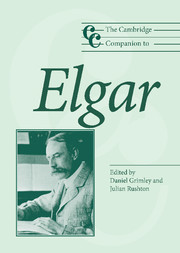Book contents
- Frontmatter
- 1 Introduction
- 2 Elgar and his British contemporaries
- 3 Elgar and his publishers
- 4 Magic by mosaic: some aspects of Elgar's compositional methods
- 5 Elgar's musical language: the shorter instrumental works
- 6 The early choral works
- 7 Elgar's later oratorios: Roman Catholicism, decadence and the Wagnerian dialectic of shame and grace
- 8 Roman Catholicism and being musically English: Elgar's church and organ music
- 9 ‘A smiling with a sigh’: the chamber music and works for strings
- 10 In search of the symphony: orchestral music to 1908
- 11 The later orchestral music (1910–34)
- 12 Elgar's unwumbling: the theatre music
- 13 Elgar and recording
- 14 Broadcasting's ally: Elgar and the BBC
- 15 Elgar in German criticism
- 16 Functional music: imperialism, the Great War, and Elgar as popular composer
- Notes
- Select bibliography
- Index
9 - ‘A smiling with a sigh’: the chamber music and works for strings
Published online by Cambridge University Press: 28 September 2011
- Frontmatter
- 1 Introduction
- 2 Elgar and his British contemporaries
- 3 Elgar and his publishers
- 4 Magic by mosaic: some aspects of Elgar's compositional methods
- 5 Elgar's musical language: the shorter instrumental works
- 6 The early choral works
- 7 Elgar's later oratorios: Roman Catholicism, decadence and the Wagnerian dialectic of shame and grace
- 8 Roman Catholicism and being musically English: Elgar's church and organ music
- 9 ‘A smiling with a sigh’: the chamber music and works for strings
- 10 In search of the symphony: orchestral music to 1908
- 11 The later orchestral music (1910–34)
- 12 Elgar's unwumbling: the theatre music
- 13 Elgar and recording
- 14 Broadcasting's ally: Elgar and the BBC
- 15 Elgar in German criticism
- 16 Functional music: imperialism, the Great War, and Elgar as popular composer
- Notes
- Select bibliography
- Index
Summary
Elgar's historical reputation has rested on his large-scale orchestral music. Through the success of the ‘Enigma’ Variations and the First Symphony in particular, he was seen as the first British composer to have created symphonic music of international scale and importance. Similarly, his last major orchestral work, the Cello Concerto, has often been heard as a retrospective farewell to the whole legacy of nineteenth-century Romantic music – in Michael Kennedy's evocative phrase, ‘music of wood smoke and autumn bonfires, of the evening of life’. While Elgar's choral works have likewise achieved canonic status in the modern repertoire, and the variations and the symphonies belong to the most elevated genre of Austro-German absolute music, Elgar's chamber music and works for strings occupy a more ambivalent historical position. Though the chamber music engages with a venerable tradition of serious instrumental works, Elgar's contribution has sometimes seemed conservative or backward-looking, especially alongside his dynamic work in the modern symphonic field. His works for string orchestra occupy a separate generic category, one that has tended to equate lightness of scoring with lack of musical depth (compare the rhetorical weight of a serenade as opposed to a symphony). But this view is not universally held. For many, Elgar's chamber works offer a vivid summing-up of his life's musical experience. Similarly, among Elgar's varied works for string ensemble, one outstanding masterpiece, the Introduction and Allegro, has had a catalysing influence on later English string music. In this sense, among others, Elgar’s chamber music and works for strings are central to any assessment of his compositional output.
- Type
- Chapter
- Information
- The Cambridge Companion to Elgar , pp. 120 - 138Publisher: Cambridge University PressPrint publication year: 2005
- 1
- Cited by



